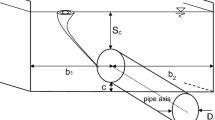Abstract
Increasing cavitation in a flowing liquid in a pipe system is associated with increasing levels of sound or noise and vibrations. It can lead to large loads if steam bubbles implode close to the pipe wall, which can be harmful to the pipe system. It can lead to fatigue due to vibrations and even worse, erosion of the pipe wall. In the worst case, it can lead to a pipe break. Therefore, cavitation is essential to be predicted and prevented in system design. The aim here is to experimentally verify a concept for the elimination of strong cavitation and harmful cavitation induced vibrations. It has been experimentally demonstrated that replacing a conventional orifice plate with three stages of multi-hole orifice plates in series with only a total streamwise distance of two pipe diameters, giving the same total pressure drop, is sufficient for the elimination of strong cavitation. The cavitation induced vibration levels are reduced by almost 500%. The streamwise distance is almost 500% shorter if multiple conventional orifice plates were to be employed. The same conclusions hold for tests performed with β = 0.30 and 0.40. This compact design was successfully applied at a nuclear power plant, and the reduction of the cavitation induced vibration levels was confirmed. The main contribution is the quantification of the vibration levels, how they depend on the type of orifice plates (conventional, multi-hole, and multi-stage-multi-hole), and how they scale with the dynamic pressure. This will be used for the validation of future CFD simulations including Fluid Structure Interaction (FSI) and advanced two-phase models.
Similar content being viewed by others
Abbreviations
- x :
-
stream wise distance from the orifice plate (m)
- t :
-
time (s)
- D :
-
pipe diameter (mm)
- d :
-
orifice diameter (mm)
- β :
-
orifice plate diameter ratio d/D (—)
- A :
-
area (m2)
- Q :
-
flowrate (L/s)
- u :
-
bulk velocity (m/s)
- T :
-
temperature (°C)
- P :
-
pressure (bar)
- P s :
-
static pressure (bar)
- p d :
-
dynamic pressure (bar)
- p atm :
-
atmospheric pressure (bar)
- p sat :
-
saturation pressure (bar)
- ΔP :
-
pressure drop (bar)
- ξ :
-
pressure loss coefficient (—)
- σ :
-
cavitation number (—)
- ρ :
-
density (kg/m3)
References
ANSYS. 2018. ANSYS Fluent User’s Guide (Release 19.0).
Bagade, V. S., Suryawanshi, P. M., Nalavade, S. M. 2019. A review of multi-hole orifice plate. Int J Res Appl Sci Eng Technol, 7: 3197–3208.
Brennen, C. E. 1995. Cavitation and Bubble Dynamics. USA: Oxford University Press.
Bremond, N., Arora, M., Dammer, S. M., Lohse, D. 2006. Interaction of cavitation bubbles on a wall. Phys Fluids, 18: 121505.
Đurđević, M., Bukurov, M., Tasin, S., Bikić, S. 2021. Numerical study of single-hole and multi-holes orifice flow parameters. J Appl Fluid Mech, 14: 215–226.
Ferrarese, G., Messa, G., Rossi, M., Malavasi, S. 2015. New method for predicting the incipient cavitation index by means of single-phase computational fluid dynamics model. Adv Mech Eng, 3: 1–11.
He, C., Lai, J., Yan, J., Xi, Z., Yuan, S., Sun, L. 2016. Research on vibration issue due to pipe orifice cavitation. Nucl Power Eng, 37: 65–69. (in Chinese)
Idelchik, I. E. 1960. Handbook of Hydraulic Resistance. Cleveland, USA: CRC Press.
International Organization for Standardization (ISO). 2003. ISO 5167-2, Measurement of Fluid Flow By Means of Pressure Differential Devices Inserted in Circular-Cross Section Conduits Running Full—Part 2: Orifice Plates. Geneva: International Organization for Standardization.
Lee, G., Jhung, M., Bae, J., Kang, S. 2021. Numerical study on the cavitation flow and its effect on the structural integrity of multistage orifice. Energies, 14: 1518.
Miller, D. S. 2009. Internal Flow Systems, 2nd edn. Marietta, GA, USA: Miller Innovations.
Rudolf, P., Kubina, D., Kozák, J., Hudec, M., Pochylú, F. 2017. Dynamics of the cavitating flow downstream of the orifice plate. AIP Conf Proc, 1889: 020033.
Bistafa, S. R., Lauchle, G. C., Reethof, G. 1989. Noise generated by cavitation in orifice plates. J Fluids Eng, 111: 278–289.
Takahashi, K., Matsuda, H., Miyamoto, H. 2001. Cavitation characteristics of restriction orifices (experiment for shock pressure distribution by cavitation on restriction orifices and occurrence of cavitation at multiperforated orifices due to interference of butterfly valve). In: Proceedings of the 4th International Symposium on Cavitation, Pasadena, CA, USA.
Testuda, P., Moussoua, P., Hirschbergb, A., Auráganc, Y. 2007. Noise generated by cavitating single-hole and multi-hole orifices in a water pipe. J Fluids Struct, 23: 163–189.
Tullis, J. P. 1993. Cavitation Guide for Control Valves. Nuclear Regulatory Commission.
Tung, P. C., Mikasinovic, M. 1983. Eliminating cavitation from pressure-reducing orifices. Chem Eng, 90: 69–71.
Acknowledgements
Vattenfall AB is acknowledged for the financial support internally.
Author information
Authors and Affiliations
Corresponding author
Additional information
Declaration of competing interest
The authors have no competing interests to declare that are relevant to the content of this article.
Rights and permissions
About this article
Cite this article
Kristian, A. Elimination of cavitation induced vibrations in orifice plates. Exp. Comput. Multiph. Flow 4, 310–317 (2022). https://doi.org/10.1007/s42757-021-0114-6
Received:
Revised:
Accepted:
Published:
Issue Date:
DOI: https://doi.org/10.1007/s42757-021-0114-6




